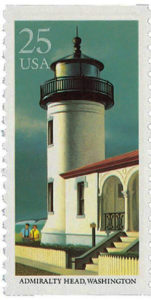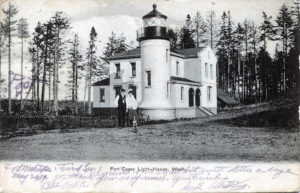This article was originally published in the January 2022 issue of 48° North.
When cruising north from Seattle, I always look for the Admiralty Head Lighthouse. There, on a windswept bluff on the west side of Whidbey Island, stands one of the prettiest beacons in Washington. The U.S. Postal Service agreed, selecting this structure to feature in its commemorative lighthouse series in 1990. But the Admiralty Head Lighthouse offers more than a lovely façade — it serves as a symbol of our region’s maritime history and the role of navigation in colonization, commercial shipping, and national defense.
The Original Light Station and Its Keepers

Admiralty Inlet connects the eastern end of the Strait of Juan de Fuca to Puget Sound. This is the ancestral home of Coast Salish Peoples, who have lived on Whidbey Island for centuries. During the 19th century, the U.S. Lighthouse Board surveyed the inlet, noting its importance to commercial sailing vessels carrying lumber, oysters, and other goods from Washington Territory to the world. As a result, Admiralty Head, a promontory on Whidbey Island marking the entrance to this strategic waterway, became the site of the first lighthouse in Puget Sound in 1861. The original station included a two-story wooden structure painted white, placed on 10 acres of bluff overlooking the inlet. The tower featured a fixed, fourth-order Fresnel lens designed to help ships avoid shallow depths as they tacked through its narrow entrance.
Captain William Robertson was Admiralty Head Light’s first keeper. A “grey grizzled sea dog,” Robertson had sailed around Cape Horn, landing in San Francisco around the time of the Gold Rush before heading to Whidbey Island to homestead with his family. He held the position for just a few years. Robertson, according to an article in the Seattle Daily Times, “got his job because he was a Democrat and lost it because he was not a Republican,” which suggested the role politics played in lighthouse assignments.
In 1864, Daniel N. Pearson assumed the duties of keeper, with his daughters Georgia, and later, Flora, serving as assistants. Georgia and Flora had arrived with the “Mercer Girls” who traveled on Asa Mercer’s first and second voyages – ventures intending to relocate marriageable women from the east coast to Puget Sound (later popularized by the television series “Here Come the Brides”). By all accounts, the teenaged Flora was very popular among lighthouse inspectors. Years later, the Seattle Daily Times described her as “the perennial queen of Island women.” She kept the logs in the early days of the light station, even after marrying Coupeville farmer William B. Engle in 1876. Notably, she recorded the birth of her son a year later in the logbook, and she became known for her “persistent” use of the spelling “Whidby” when referring to the island. Her father resigned as keeper in 1878, moving to a farm in Coupeville and Flora soon followed. The original lighthouse remained operational for only a few decades after that.
The New Lighthouse

Events thousands of miles away would determine the fate of the Admiralty Head Lighthouse. During the 1890s, the U.S. Army selected this location on Whidbey Island to establish Fort Casey — one of three Coast Artillery forts installed to defend the region. The sinking of the U.S. naval ship Maine in Havana Harbor in 1898 inflamed tensions between the United States and Spain, leading to the outbreak of the Spanish-American War and pointing to the need for defense of the U.S. coastline. Built at the turn of the 20th century, the three installations – Fort Casey at Admiralty Head, Fort Flagler south of Port Townsend, and Fort Worden at Point Wilson – formed a “triangle of fire” intended to repel enemy vessels entering Admiralty Inlet. The original wooden lighthouse at Admiralty Head sat on the spot where the Army wanted to establish a “disappearing gun” battery, and was relocated nearby where it was used for other purposes. In 1903, the U.S. Army Corps of Engineers built the new — and current — beacon on the bluff at Admiralty Head.
Carl W. Leick, a well-known architect of many of our region’s lighthouses, designed the new station. The structure included 18 inches of brick walls covered with stucco, built to withstand the blast of Fort Casey’s guns. It was painted white with green trim and a red roof. The fourth-order Fresnel lens from the original tower was installed in the lantern in the new structure which, unlike the original, featured a round, conical shape. A shed for whale oil and other fuel sat nearby, while a two-story keeper’s residence stood attached to the tower. Inside were several bedrooms, a parlor, kitchen, and dining room — comfortable and modern accommodations by the standards of the day. Much of the station’s unique charm came from its Spanish-style architecture, evident in the arches, stepped parapet wall, and flourishes in the ironwork.
The lighthouse’s service was short-lived. In 1922, after only 19 years, it was decommissioned, as steamships increasingly had replaced sailing vessels during the early 20th century, reducing the need for multiple aids in navigating the shoals of Admiralty Inlet. In 1927, the Lighthouse Service removed the lantern from the Admiralty Head Lighthouse, placing it at the New Dungeness Lighthouse on the Strait of Juan de Fuca. Except for a brief period during World War II when the U.S. Army used it as barracks, the light station stood neglected and in disrepair for decades. Vandals nearly destroyed the property. “Not a window remained intact in the building,” the Seattle Times wrote about the old lighthouse in 1959, “and some of the window frames had been stolen.”
Restoring an Old Treasure
During the late 1950s, the Washington Parks and Recreation Commission joined the Island County Historical Society in a major effort to restore the lighthouse. In addition to reconstructing the glass lantern room, these agencies repaired cracks in the brick wall, painted the entire structure, and acquired a fourth-order Fresnel lens for display. The restored light station was included in Fort Casey’s interpretive program and opened to the public. In 1980, the lighthouse was incorporated into the Ebey’s Landing National Historic Reserve as part of Fort Casey State Park.
Today, the Admiralty Head Lighthouse — outside and interior — remains open to the public. And the next time you cruise by the west side of Whidbey Island, watch for a break in the trees just south of the open fields of Ebey’s Landing. You may be rewarded with a glimpse of this stunning beacon and remnant of Salish Sea history.
Learn more at: https://parks.state.wa.us/505/Fort-Casey






